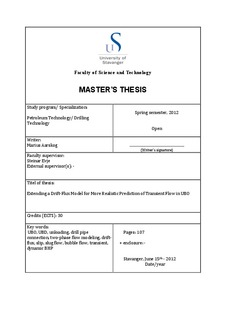| dc.contributor.author | Aarskog, Marius | |
| dc.date.accessioned | 2012-11-07T11:56:43Z | |
| dc.date.available | 2012-11-07T11:56:43Z | |
| dc.date.issued | 2012 | |
| dc.identifier.uri | http://hdl.handle.net/11250/183476 | |
| dc.description | Master thesis in Petroleum engineering | no_NO |
| dc.description.abstract | The transient behavior of the bottomhole pressure during underbalanced drilling operations has been investigated. Focus has been on jointed pipe drilling with gas injection through the drill string. A description is made of a two‐phase drift‐flux model. The model has previously been developed in Matlab and is modeled to simulate the dynamic bottomhole pressure, during transient conditions in underbalanced operations. The original model only recognizes the slug flow regime and its corresponding slip parameters are implemented through the general slip law [29]. Extension has been made to the original model by including a model that distinguishes between bubble flow and slug flow, based on a simplified version of the suggestions made by Caetano [22]. Values for the slip parameters were chosen depending on existing flow pattern. For the transition zone, interpolation technique was used. The velocity profile coefficient for bubble flow was suggested to be 1.0 by Caetano, however, as this made oscillations in the simulation results a value of 1.1 was adapted, as proposed by Lage and Time [34]. Simulation runs of two‐phase flow in a vertical well were performed using the original model, the bubble slip parameters and the flow pattern dependent model. The results of the bubble flow model was compared to the original model, showing that after the unloading sequence, the bottomhole pressure was found to be 18.3 % lower than for the original model. The unloading sequence was also found to last 47 % longer for the bubble flow model. The results gained from the flow pattern dependent model concluded that the slug flow region is the main flow regime during the simulation. However, until break through of gas during the unloading sequence, the bubble flow regime was found to be the primary flow pattern. | no_NO |
| dc.language.iso | eng | no_NO |
| dc.publisher | University of Stavanger, Norway | no_NO |
| dc.relation.ispartofseries | Masteroppgave/UIS-TN-IPT/2012; | |
| dc.subject | petroleumsteknologi | no_NO |
| dc.subject | flow modeling | no_NO |
| dc.subject | boreteknologi | no_NO |
| dc.subject | two‐phase flow modeling | no_NO |
| dc.subject | drift-flux | no_NO |
| dc.subject | bubble flow | no_NO |
| dc.subject | dynamic BHP | no_NO |
| dc.subject | UBO | no_NO |
| dc.subject | UBD | no_NO |
| dc.title | Extending a drift-flux model for more realistic prediction of transient flow in UBO | no_NO |
| dc.type | Master thesis | no_NO |
| dc.subject.nsi | VDP::Technology: 500::Rock and petroleum disciplines: 510::Petroleum engineering: 512 | no_NO |
| dc.source.pagenumber | 107 | no_NO |
